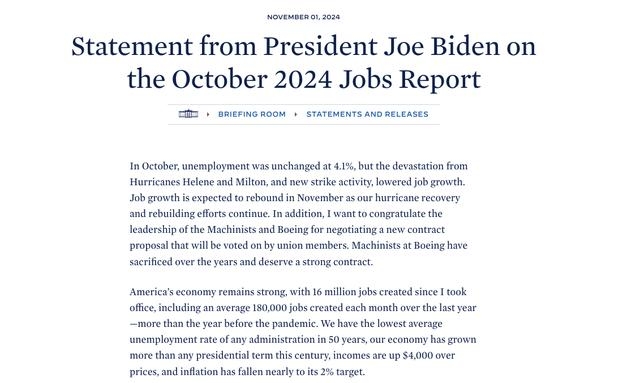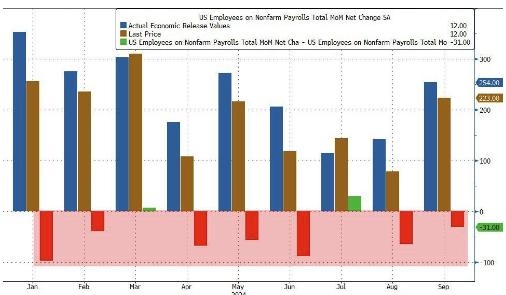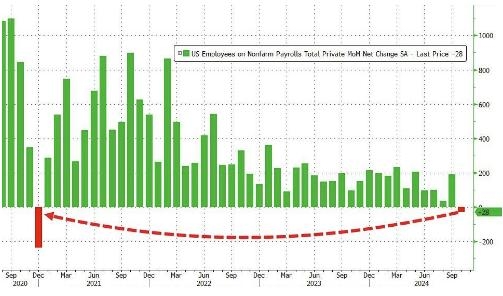Financial Association, November 1 (Editor: Shi Zhengcheng) As the U.S. October non-farm employment data unfolded dramatically, various market participants interpreted the data itself and various derivative topics from different angles.
First, as a prelude, the non-farm data released on Friday showed only a mere 12,000 jobs. Although influenced by two major hurricanes and a Boeing strike, this number significantly fell short of market expectations (113,000). Interestingly, the unemployment rate rose from 4.05% to 4.14%, which rounds to '4.1%'.
For the capital market, it is also pleased to see data that consolidates the Fed's rate-cutting cycle. As of the time of writing, all three major U.S. stock indices have risen by more than 1%.
What’s more interesting is the different interpretations of the same data by various parties.
Biden: Remember! I created 16 million jobs.
As per tradition, President Joe Biden's office continues to release statements regarding the non-farm data. This article simply brushes over the '12,000' figure with 'slow employment'.

(Source: White House)
Biden stated in a release that the unemployment rate in October remained unchanged at 4.1%, but due to the slow employment caused by hurricanes and strikes, a rebound is expected in November. Afterwards, the soon-to-retire Biden specifically emphasized that he created a total of 16 million jobs during his tenure, averaging 180,000 per month, while the unemployment rate during his term is also the lowest in nearly 50 years.
There is no doubt that Trump's team immediately wielded the employment report against Harris. Trump's spokesperson, Caroline Levitt, stated in a release that Friday's job growth is a 'disaster', clearly revealing 'how Kamala Harris has severely damaged the U.S. economy'.
Clearly, investors are well aware that the reasons for the poor data are related to larger disasters. Trump's allies have been accusing the Biden administration of 'manipulating employment data' for political gain, which the White House has vehemently denied.
However, this employment data indeed has a series of coincidences worth noting.
Don't forget about the 'American-style downward revision'
It is important to note that although factors like hurricanes and strikes have been emphasized, the vast majority of institutions aware of these two major factors also all mispredicted—according to statistics, the market consensus was 113,000. Among all public forecasts, only Bloomberg Economics (-10,000) and Dutch Bank (0) had predictions lower than the final value.
What has left the market in habitual confusion is that the U.S. Department of Labor has again revised down the employment data for the previous two months, with August revised down by 81,000 and September down by 31,000. According to statistics, the Biden Department of Labor has revised non-farm data downward after its release in 7 out of 9 months this year, erasing a cumulative total of 818,000 jobs.

This also means that the non-farm reports for November and December will have a point of interest - the mere 12,000 jobs in October, if revised down further, could actually turn negative!
The more important detail is that while the October non-farm data barely showed a positive result, excluding the addition of 40,000 government jobs, private employment is actually negative, marking the first time it has turned negative since December 2020.

As for the 'unquantifiable impact of hurricanes' that the labor data statistical department particularly emphasized, the well-known financial blog ZeroHedge provided a rather conspiracy-theory flavored 'translation': When the data is released next month, if Trump becomes president, it would maintain the downward trend in employment, equivalent to 'acknowledging the true state of the labor market'; but if Harris wins, it would provide a 'magical rebound' in the data, even if more severe 'downward revisions' are needed.
General consensus: Confirm that the rate cut next week is set.
For Wall Street analysts, Friday's data is more of a 'one-time surprise', making it difficult to extract more insights about the economy and rate cuts.
Seema Shah, Global Chief Strategist at Signia Global Investments, stated that deeper reflection on the numbers indicates that amidst all the noise and disruptions, the labor market is basically slowing down. The consensus forecast of adding 100,000 jobs has already taken the hurricane impact into account, so significant downward surprises indicate potential weakness. This reaffirms that the Fed must maintain its easing cycle, and a 25 basis points cut could occur in November and December.
Charlie Ripley, Vice President of Portfolio Management at Allianz Investment Management, stated that overall, this report does not provide much information to determine the trend of the labor market, which makes it likely that the Fed will lower rates by 25 basis points next week. It seems we need to wait another month for economic data to better assess the Fed's monetary policy direction.
Anna Wong, Bloomberg's Chief U.S. Economist, who successfully predicted tonight's data, stated that excluding temporary factors and adjusting for exaggerations in the data, the underlying job growth may be below the pace needed to stabilize the unemployment rate, forecasting that the unemployment rate will rise again in the coming months. The October employment report will lead the Fed to cut rates by 25 basis points as planned on November 7.
Jason Pride, Chief Investment Officer of Glenmede, a boutique wealth management firm, stated that investors should remain cautious about this report, as there may be large revisions in the coming months. The Fed does not have many clear indicators, but some underlying data seems strong enough for them to cut rates by 25 basis points next week.
Pride predicts that under normal circumstances without major disruptions, the baseline scenario should be a further 50 basis points cut this year and additional cuts in 2025, stabilizing around 3%-3.5% by mid-year.
(Financial Association, Shi Zhengcheng)


